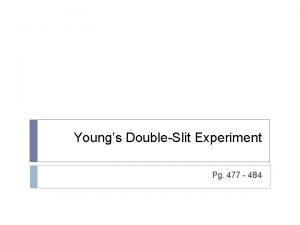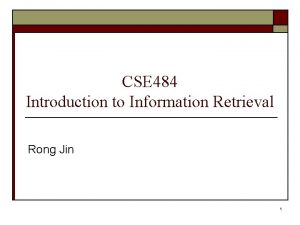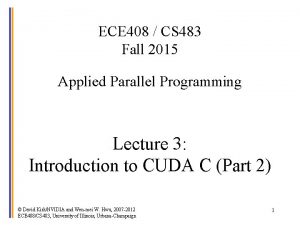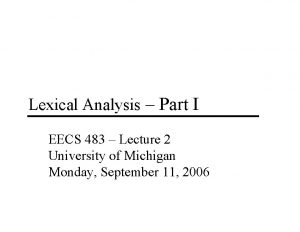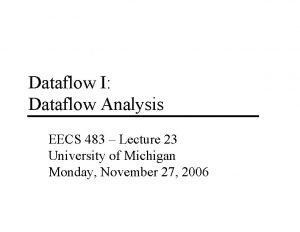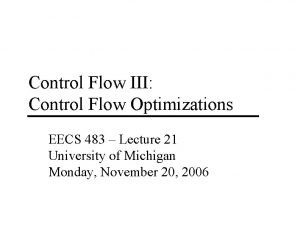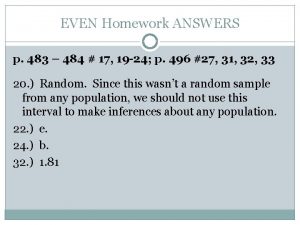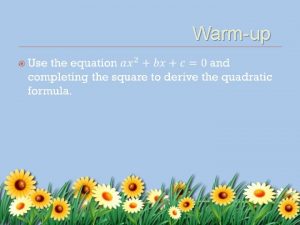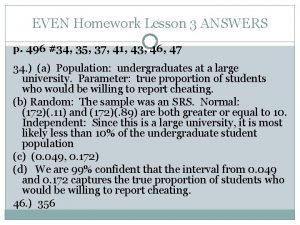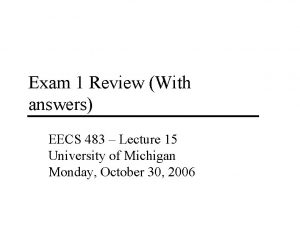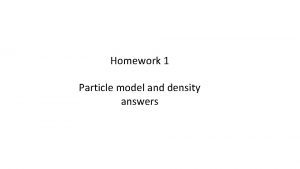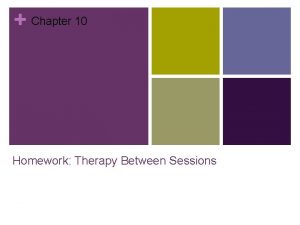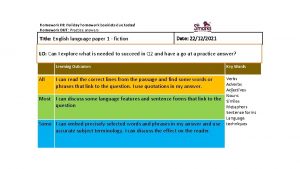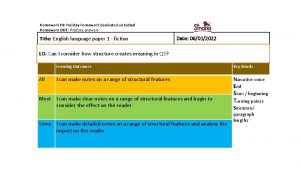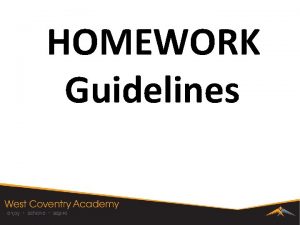EVEN Homework ANSWERS p 483 484 17 19


















- Slides: 18

EVEN Homework ANSWERS p. 483 – 484 # 17, 19 -24; p. 496 #27, 31, 32, 33 20. ) Random. Since this wasn’t a random sample from any population, we should not use this interval to make inferences about any population. 22. ) e. 24. ) b. 32. ) 1. 81

WARM UP! A manufacturer of flashlights wants to know how well one of their newer styles is selling in a chain of large home-improvement stores. They select an SRS of 20 stores, record how many flashlights are sold in a 30 -day period, and construct at 95% CI for the mean number of flashlights sold. a) Check the conditions for constructing a CI. If you think one of them has not been met, what additional info would be required or what change in the study would you make? Random: An SRS of 20 stores was taken. Normal: We don’t know if the # of flashlights sold is Normally dist. Since n=20, we can’t be confident that the CLT applies. We either need info about the original population distribution’s shape, or we need to take a bigger sample. Independent: We are sampling stores w/0 replacement, so we need to know that there at least 20(10) = 200 stores in the population—which seems reasonable. It also seems reasonable that flashlight sales in individual stores would not affect each other.

WARM UP! B) If, instead of constructing a 95% CI, the flashlight manufacturer constructed a 98% CI instead. Would the 98% interval be wider, narrower, or the same width as the 95% interval? Explain. If our interval will have to capture the true mean 98% of the time in repeated samples instead of only 95% of the time, it will have to be WIDER. C) How would the width of the interval change if the manufacturer took a larger sample? Explain. If the sample size is larger, then the st. dev. will be smaller, so the CI will be narrower.

Unit 8 Lesson 3 ESTIMATING A POPULATION PROPORTION (SECTION 8. 2) PART 2

OBJECTIVES �Determine the sample size required to obtain a level C confidence interval for a population proportion with a specified margin of error. �Understand how the margin of error of a confidence interval changes with the sample size and the level of confidence C. �Understand why each of the three inference conditions – Random, Normal, and Independent – is important.

Confidence Intervals – 4 Step Process �On any free-response AP exam question where it asks you to construct and interpret a confidence interval, you are expected to do a detailed 4 -step process! STATE – The parameter you want to estimate and the confidence level. PLAN – Inference method used and check all conditions. DO – If the conditions check out, do the calculations CONCLUDE – Interpret the conf. interval in terms of the problem

EXAMPLE: Kissing the right way? � According to an article in the San Gabriel Valley Tribune (February 13, 2003), “Most people are kissing the ‘right way’”. This is, according to the study, the majority of couples tilt their heads to the right when kissing. In the study, a researcher observed a random sample 124 couples kissing in various public places and found that 83/124 (66. 9%) of the couples tilted to the right. � Construct and interpret a 95% confidence interval for the proportion of all couples who tilt their heads to the right when kissing.

EXAMPLE (Answer) STATE – The parameter you want to estimate and the confidence level. �STATE: We want to estimate p=the true proportion of couples who tilt their heads to the right when kissing at the 95% confidence level.

EXAMPLE (Answer) PLAN – Name the Inference method and check conditions. �PLAN: We will use a one-sample z interval for p if the following conditions are satisfied. Random: The researcher observed a random sample of 124 couples. Normal: and Independent: The number of couples in the population is at least 10(124) = 1240, and no couple would affect another.

EXAMPLE (Answer) DO – If the conditions check out, do the calculations—show your work!! �DO:

EXAMPLE (Answer) CONCLUDE – Interpret the conf. interval in terms of the problem �CONCLUDE: We are 95% confident that the interval from 0. 586 to 0. 752 captures the true proportion of couples who tilt their heads to the right when kissing. �See another 4 -step problem on p. 491 in book

Calculator Directions �To do this in the calculator, follow these directions: STAT TESTS A: 1 -Prop. ZInt Type in the number of “successes” for x, the number of your sample size for n, and the confidence level (out of percent form) Highlight Calculate, and press ENTER. The confidence interval is in the parentheses, then the sample proportion and the sample size. �What if I don’t show my work and just use my calculator? You won’t get any credit on the test and with the AP exam, it’s risky.

Choosing the Sample Size �When you start planning a study, you might be unsure how large of a sample you want, but you might have an idea of the margin of error you want it to be/keep below. This part �Recall the confidence interval for estimating a represents population’s proportion your margin of error �If we want to keep it within a specific margin of error, we can set up an inequality that would look like this:

Choosing the Sample Size � This critical value will be determined by the Confidence This n is what we want to level (given to you in the solve for! problem) Wait, how do we know the sample proportion if we don’t know the sample size? !

EXAMPLE - Tattoos �Suppose that you wanted to estimate p = the true proportion of students at your school who have a tattoo with a 95% confidence and a margin of error of no more than 0. 10. �Determine how many students should be surveyed to estimate to within 0. 10 with 95% confidence.

EXAMPLE – Tattoos (Solution) �Since we don’t have any previous knowledge of the proportion of students with a tattoo, we will use to estimate the sample size needed. �Because of rounding error and to make sure that our sample size will stay below the margin error of 0. 10, we will round up. �So we need to survey at least 97 students to estimate the true proportion of students with a tattoo with 95% confidence and a margin of error of at most 0. 10.

EXIT TICKET �Complete the Exit Ticket and turn it in before you leave!

Homework problems �QUIZ next class!! �Read textbook pages: p. 490 -495 �Complete exercises: p. 496 #34, 35, 37, 41, 43, 46, 47, 49 -52 �Check answers to odd problems
 Experiment 477
Experiment 477 Cse484
Cse484 Cs 484 bilkent
Cs 484 bilkent 484 bc
484 bc Recursive language in automata
Recursive language in automata Regular expression of even even language
Regular expression of even even language Jack prelutsky homework oh homework
Jack prelutsky homework oh homework Homework oh homework i hate you you stink
Homework oh homework i hate you you stink Parts of a poem
Parts of a poem Jack prelutsky homework oh homework
Jack prelutsky homework oh homework Homework oh homework i hate you you stink
Homework oh homework i hate you you stink Literal language examples
Literal language examples Ley del notariado plurinacional
Ley del notariado plurinacional Uiuc cs 483
Uiuc cs 483 Biba n 477 ddl
Biba n 477 ddl Eecs 483
Eecs 483 Eecs 483
Eecs 483 Sebuah lampu natrium 20 watt berwarna kuning
Sebuah lampu natrium 20 watt berwarna kuning Eecs483
Eecs483
